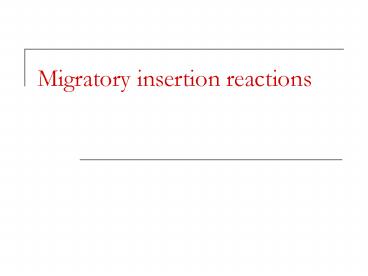Migratory insertion reactions - PowerPoint PPT Presentation
1 / 19
Title:
Migratory insertion reactions
Description:
At higher temperatures the entropy loss becomes more important: DG will be ... co-catalyst generated from the adventitious water, 'methylalumoxane(s)' or MAO: ... – PowerPoint PPT presentation
Number of Views:718
Avg rating:3.0/5.0
Title: Migratory insertion reactions
1
Migratory insertion reactions
2
Outline
- Book 3, chapter 9
- Migratory insertions
3
Migratory insertions
Two possible mechanisms
Labeling studies show that Me migrates.
4
Stereochemistry of migrating C center
5
Hydroformylation Thermodynamics
Thermodynamics at standard conditions
At higher temperatures the entropy loss becomes
more important DG will be less negative. The TD
favored product is the alkane. The obtained
product is the aldehyde because of kinetic
control.
6
Mechanism of the Co-catalyzed hydroformylation
All steps are reversible, except product
formation, which is often rate-determining.
Preferential formation of the linear product is
due to steric interactions.
Hydrogenolysis is the rate-determining step for
simple terminal olefins. Trapping of the alkyl by
CO determines the regioselectivity.
7
Bonding in alkene complexes
Dewar-Chatt-Duncanson model
8
Hydrogenation of olefins
H2 adds to the catalyst before the olefin. The
last step of the catalytic cycle is irreversible.
This is very useful because a kinetic product
ratio can be obtained.
Simplistically, the relative rates suggest that
the rate-determining step is OA of H2.
9
Ziegler/Natta polymerization introduction
- Karl Ziegler German chemist, Nobel prize 1963
- 1953/54 oligomerization of ethylene by
trialkylaluminum compounds (high pressure and
temperature). - In the presence of trace transition metals, it
was found that the reaction took place at a much
lower temperature and pressure. - Polymer had a linear, unbranched structure
with high molecular weight, i.e. HDPE
- Giulio Natta Italian chemist, Nobel prize 1963
- Learned of Zieglers research, and applied
findings to other a-olefins such as propylene and
styrene. - Resulting polypropylene was made up of two
fractions amorphous (atactic) and crystalline
(tactic). Polypropylene is not produced in
radical initiated reactions.
http//www.nobel.se/chemistry/laureates/1963/
10
Metallocene catalysts
- 1955 Natta reported that Cp2TiCl2 activated
by AlEt3 could polymerize ethylene with low
activities. - 1981 Sinn and Kaminsky discovered a high
activity catalyst
- The key to reactivity was the co-catalyst
generated from the adventitious water,
methylalumoxane(s) or MAO
11
Activation of metallocenes and olefin insertion
- The active metallocene catalyst is a cationic
alkyl.
- The alkyl resides in one of the equatorial
sites and the olefin binds to the other.
12
2005 Nobel prize in chemistry
"for the development of the metathesis method in
organic synthesis"
Richard Schrock Massachusetts Institute of
Technology (MIT) Cambridge, MA, USA
Yves Chauvin Institut Français du Pétrole
Rueil-Malmaison, France
Robert Grubbs California Institute of Technology
(Caltech) Pasadena, CA, USA
http//nobelprize.org/chemistry/laureates/2005/ind
ex.html
13
MC complexes comparison
14
Carbene complexes Fischer-type
15
Alkylidene complexes Schrock-type
16
Olefin metathesis
Mechanism
Such cycloaddition reactions between two alkenes
to give cyclobutanes are symmetry forbidden and
occur only photochemically. However, the presence
of d-orbitals on the metal alkylidene fragment
breaks this symmetry and the reaction is quite
facile. Normally, the products are statistical,
unless the reaction can be driven in some way or
the two alkenes have very different reactivities.
Reference Chem. Eng. News 2002, Dec 23,
34-38 http//nobelprize.org/nobel_prizes/chemistry
/laureates/2005/animation.html
17
Reaction overview
18
Grubbs catalysts
Reference Trnka, T. M. Grubbs, R. H. Acc. Chem.
Res. 2001, 34, 18
19
Mechanism with Grubbs catalysts

